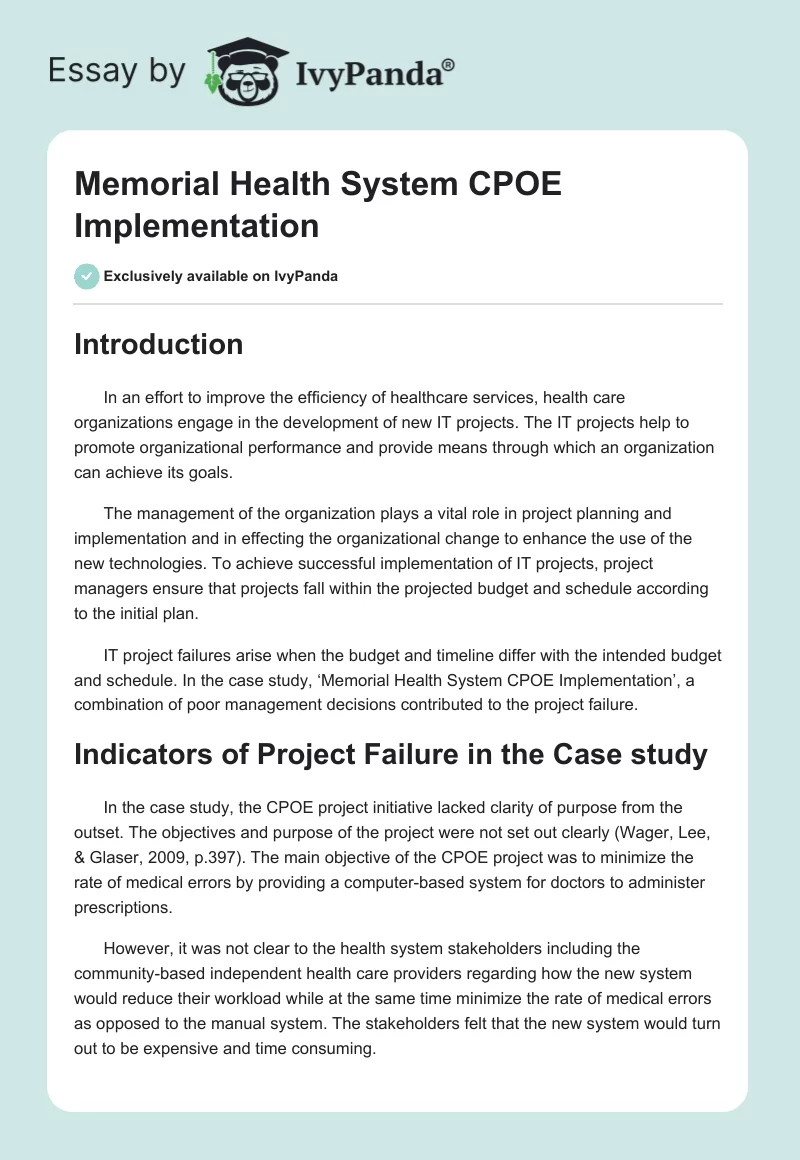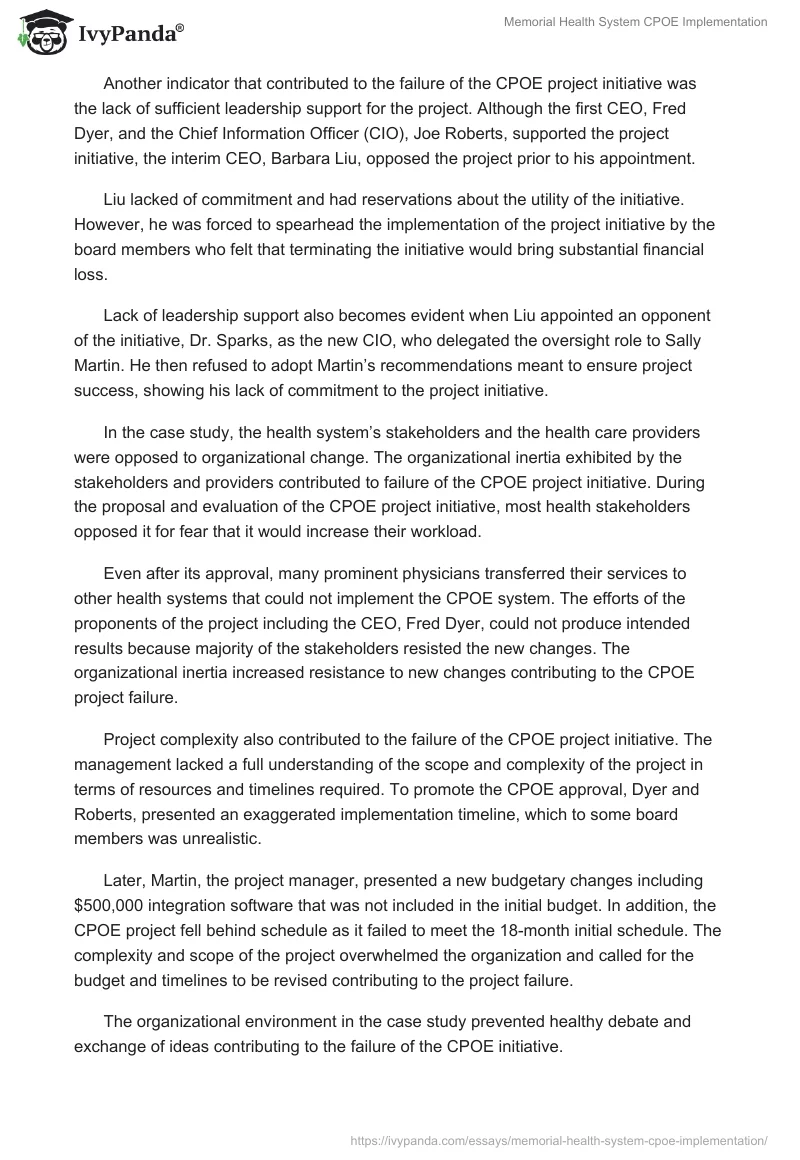Introduction
In an effort to improve the efficiency of healthcare services, health care organizations engage in the development of new IT projects. The IT projects help to promote organizational performance and provide means through which an organization can achieve its goals.
The management of the organization plays a vital role in project planning and implementation and in effecting the organizational change to enhance the use of the new technologies. To achieve successful implementation of IT projects, project managers ensure that projects fall within the projected budget and schedule according to the initial plan.
IT project failures arise when the budget and timeline differ with the intended budget and schedule. In the case study, ‘Memorial Health System CPOE Implementation’, a combination of poor management decisions contributed to the project failure.
Indicators of Project Failure in the Case study
In the case study, the CPOE project initiative lacked clarity of purpose from the outset. The objectives and purpose of the project were not set out clearly (Wager, Lee, & Glaser, 2009, p.397). The main objective of the CPOE project was to minimize the rate of medical errors by providing a computer-based system for doctors to administer prescriptions.
However, it was not clear to the health system stakeholders including the community-based independent health care providers regarding how the new system would reduce their workload while at the same time minimize the rate of medical errors as opposed to the manual system. The stakeholders felt that the new system would turn out to be expensive and time consuming.
Another indicator that contributed to the failure of the CPOE project initiative was the lack of sufficient leadership support for the project. Although the first CEO, Fred Dyer, and the Chief Information Officer (CIO), Joe Roberts, supported the project initiative, the interim CEO, Barbara Liu, opposed the project prior to his appointment.
Liu lacked of commitment and had reservations about the utility of the initiative. However, he was forced to spearhead the implementation of the project initiative by the board members who felt that terminating the initiative would bring substantial financial loss.
Lack of leadership support also becomes evident when Liu appointed an opponent of the initiative, Dr. Sparks, as the new CIO, who delegated the oversight role to Sally Martin. He then refused to adopt Martin’s recommendations meant to ensure project success, showing his lack of commitment to the project initiative.
In the case study, the health system’s stakeholders and the health care providers were opposed to organizational change. The organizational inertia exhibited by the stakeholders and providers contributed to failure of the CPOE project initiative. During the proposal and evaluation of the CPOE project initiative, most health stakeholders opposed it for fear that it would increase their workload.
Even after its approval, many prominent physicians transferred their services to other health systems that could not implement the CPOE system. The efforts of the proponents of the project including the CEO, Fred Dyer, could not produce intended results because majority of the stakeholders resisted the new changes. The organizational inertia increased resistance to new changes contributing to the CPOE project failure.
Project complexity also contributed to the failure of the CPOE project initiative. The management lacked a full understanding of the scope and complexity of the project in terms of resources and timelines required. To promote the CPOE approval, Dyer and Roberts, presented an exaggerated implementation timeline, which to some board members was unrealistic.
Later, Martin, the project manager, presented a new budgetary changes including $500,000 integration software that was not included in the initial budget. In addition, the CPOE project fell behind schedule as it failed to meet the 18-month initial schedule. The complexity and scope of the project overwhelmed the organization and called for the budget and timelines to be revised contributing to the project failure.
The organizational environment in the case study prevented healthy debate and exchange of ideas contributing to the failure of the CPOE initiative.
The stakeholders and the healthcare providers were not consulted prior to the implementation of the project. Those opposed had to seek an alternative way of voicing their opinion; for instance, prominent physicians transferred their services to other health systems. Lack of candor is also evident when the CIO, Dr. Sparks, instructed the project manager, Martin, to report positively about the project progress despite the logistical challenges thus contributing to the project failure.
Conclusion and Recommendations
To promote the success of the CPOE project, I would have clarified the purpose of the CPOE initiative including its benefits like how the new system would minimize medical errors and reduce their workload.
This clarity would increase the support for the project, as the stakeholders would understand its benefits. In addition, to ensure success of the project, I would have ensured that only qualified and committed project manager and CIO headed the undertaking. Committed leadership would make important decisions to ensure that the initiative is successful.
To overcome organizational inertia, I would recommend training programs to enlighten the stakeholders on the necessity of the new technological changes prior to implementation for majority of people oppose change for lack of knowledge (Kerzner, 2004, p.28).
I would also recommend that the project be implemented in different phases each with a realistic timeline and sufficient resources to ensure that the implementation runs to completion. Organizational culture of candor through free communication between project managers and the leadership could help promote success of the project.
Reference List
Kerzner, H. (2004). Advanced Project Management: Best Practices on Implementation.
San Francisco: John Wiley & sons Inc.
Wager, K., Lee, F., & Glaser, J. (2009). Health Care Information Systems: A practical Approach for Health Care Management. San Francisco: John Wiley & Sons Inc.


